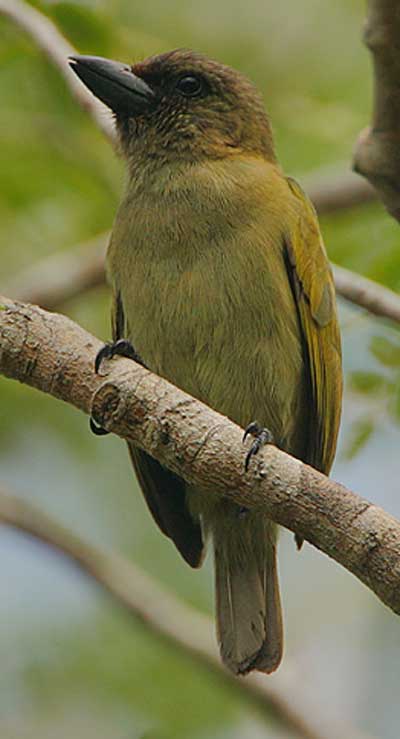
Stactolaema olivacea (*)
Superregnum: Eukaryota
Cladus: Unikonta
Cladus: Opisthokonta
Cladus: Holozoa
Regnum: Animalia
Subregnum: Eumetazoa
Cladus: Bilateria
Cladus: Nephrozoa
Superphylum: Deuterostomia
Phylum: Chordata
Subphylum: Vertebrata
Infraphylum: Gnathostomata
Megaclassis: Osteichthyes
Cladus: Sarcopterygii
Cladus: Rhipidistia
Cladus: Tetrapodomorpha
Cladus: Eotetrapodiformes
Cladus: Elpistostegalia
Superclassis: Tetrapoda
Cladus: Reptiliomorpha
Cladus: Amniota
Classis: Reptilia
Cladus: Eureptilia
Cladus: Romeriida
Subclassis: Diapsida
Cladus: Sauria
Infraclassis: Archosauromorpha
Cladus: Crurotarsi
Divisio: Archosauria
Cladus: Avemetatarsalia
Cladus: Ornithodira
Subtaxon: Dinosauromorpha
Cladus: Dinosauriformes
Cladus: Dracohors
Cladus: Dinosauria
Ordo: Saurischia
Cladus: Eusaurischia
Subordo: Theropoda
Cladus: Neotheropoda
Cladus: Averostra
Cladus: Tetanurae
Cladus: Avetheropoda
Cladus: Coelurosauria
Cladus: Tyrannoraptora
Cladus: Maniraptoromorpha
Cladus: Maniraptoriformes
Cladus: Maniraptora
Cladus: Pennaraptora
Cladus: Paraves
Cladus: Eumaniraptora
Cladus: Avialae
Infraclassis: Aves
Cladus: Euavialae
Cladus: Avebrevicauda
Cladus: Pygostylia
Cladus: Ornithothoraces
Cladus: Ornithuromorpha
Cladus: Carinatae
Parvclassis: Neornithes
Cohors: Neognathae
Cladus: Neoaves
Ordo: Piciformes
Familia: Lybiidae
Genus: Stactolaema
Species: Stactolaema olivacea
Subspecies: S. o. belcheri - S. o. howelli - S. o. hylophona - S. o. olivacea - S. o. rungweensis - S. o. ulugurensis - S. o. woodwardi
Name
Stactolaema olivacea (Shelley, 1880)
References
Ibis - the International Journal of Avian Science, published by the British Ornithologists' Union p. 334 pl.7
Vernacular names
Afrikaans: Groenhoutkapper
English: Green Barbet
The green barbet (Stactolaema olivacea) is a species of bird in the Lybiidae family (African barbets). It is found in Kenya, Tanzania, Malawi, Mozambique and South Africa.[1] It occurs in forests from sea level to 1,800 metres (5,900 ft).[2] Its isolated populations are vulnerable to forest clearing.[3]
Description
They have dull ginger-olive plumage, but are yellower on the wings, and paler below. The head and chin are dark brown in the nominate race, and the eyes vary from dull red to orange. The bill is black and the feet blackish. Juveniles are duller, with brown eyes.[4]
Call
Their call is a repetitive chock, chock, ...,[4] or chop, chop, ...,[5] sometimes in a duet.
Habits
They frequent fruiting branches in the subcanopy, and vary from solitary to social during foraging and roosting.[4] It is a sedentary species which is not known to undertake any movements.[3] It may be particularly dependent on the fruit of wild figs. It breeds in cavities in tree trunks during mid summer.[3]
Taxonomy
1897 illustration of a pair of Woodward's barbets, by J.G. Keulemans.
The number of races (or species) is not generally agreed upon, and the conservation status of the taxa depend critically on their taxonomic evaluation.[3] Race S. o. hylophona is sometimes merged with woodwardi in a taxon with tentative species status,[3] the so-called Woodward's barbet. These birds have the ear coverts and hind brow marked in yellow, as opposed to the dusky-headed populations. The type was obtained from oNgoye Forest in South Africa, and named for its discoverers, the Woodward brothers. S. o. belcheri, which lacks the yellow ear coverts,[5] is endemic to two isolated inselbergs, and may constitute a third species.[3]
Races
S. o. olivacea – coastal Kenya to uplands of central Tanzania
S. o. uluguruensis – Uluguru Mountains of eastern Tanzania[6]
S. o. howelli – East Udzungwa Mountains in Tanzania
S. o. rungweensis – Mt Rungwe and Poroto Mts, Tanzania to Misuku Hills, northern Malawi[2][5][6]
S. o. hylophona – the Ngarama, Rondo (where common) and possibly Mitundumbea forest reserves of coastal Tanzania[7]
S. o. belcheri – Mt Thyolo in Malawi and Mt Namuli in Mozambique
S. o. woodwardi – oNgoye in KwaZulu-Natal, South Africa
References
BirdLife International (2012). "Stactolaema olivacea". IUCN Red List of Threatened Species. 2012. Retrieved 26 November 2013.
Britton, P. L., ed. (1980). Birds of East Africa, their habitat, status and distribution. Nairobi: East Africa Natural History Society. p. 102.
Harisson, J.A.; et al. (1997). The atlas of southern African birds (PDF). Johannesburg: BirdLife SA. p. 716. ISBN 0-620-20730-2.
Zimmerman, Dale A.; et al. (1999). Birds of Kenya and Northern Tanzania. Princeton University Press. p. 478. ISBN 0691010226.
Newman, Ken; et al. (1992). Birds of Malawi. Blantyre: The Wildlife Society of Malawi. pp. 6, 7. ISBN 99908-31-009.
"Green Barbet". Preliminary Map. Tanzania Bird Atlas. Retrieved 22 May 2014.
"Biodiversity studies in Kilwa and Lindi Districts" (PDF). UTUMI Biodiversity Surveys. Tanzania: DANIDA, Ministry of Foreign Affairs (Ref. No. 104.Tan.1.MRS.11): 77 pages. December 2002. Retrieved 2011-06-14.
Retrieved from "http://en.wikipedia.org/"
All text is available under the terms of the GNU Free Documentation License

